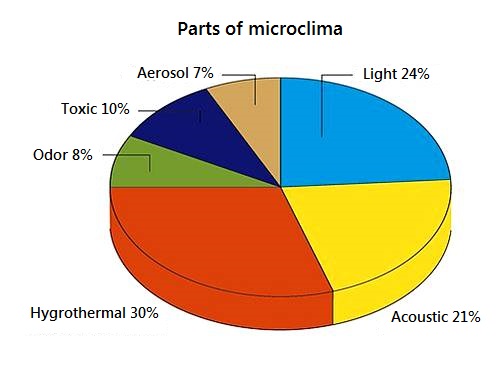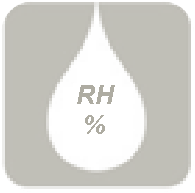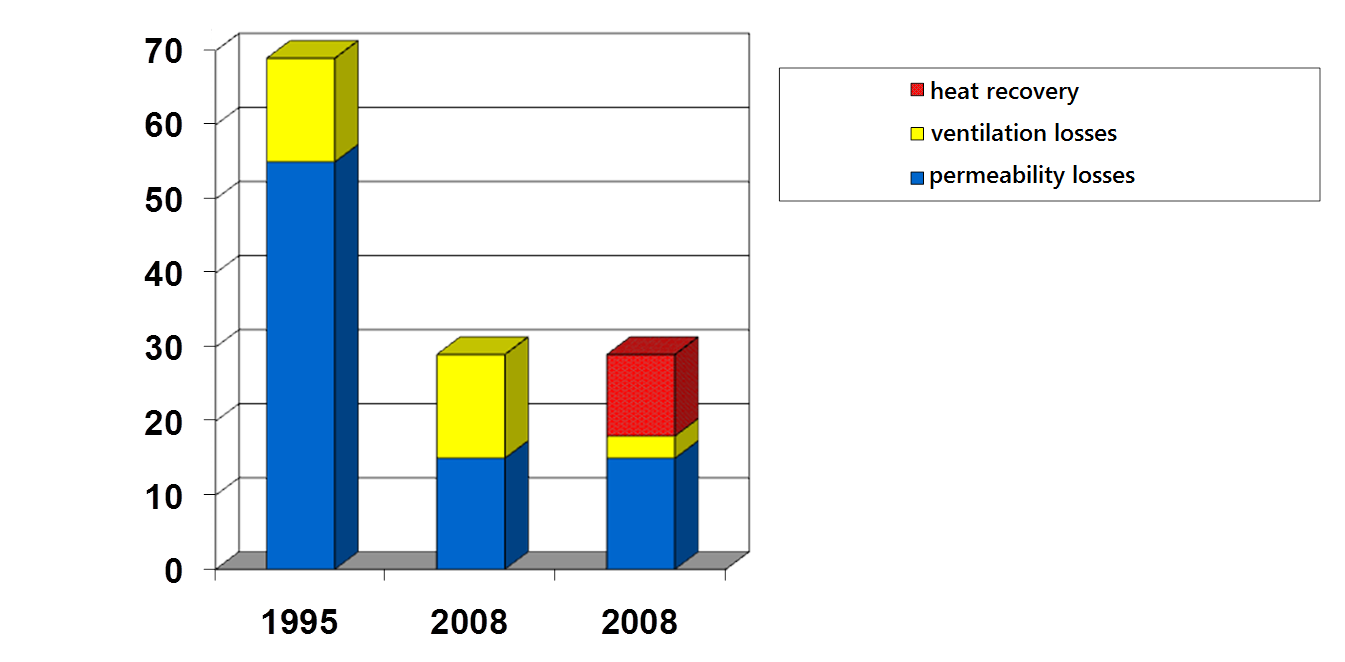

|
Where you can use heat recovery? It can be used for all residential buildings, shops, schools, buildings for sport and culture, kitchens, restaurants, industrial buildings and objects, etc. |
|
What is the ideal airflow and its efficiency? Effectiveness of recuperation defines how much heat we can have from transforming a waste air to fresh air in heat exchanger. Standard recuperators with a cross-flow heat exchanger are 60 - 70% effective. This efficiency falls down to 50% with a maximal flow. The most widely used recuperator is counter-flow recuperator. It is 97% effective. With a maximal flow it is 70% effective. These units with counter-flow heat exchanger are used for flows about 15.000 m3 per hour. Units with cross-flow heat exchanger are used for flows about 30.000 m3 per hour. |
|
How high is a saving on heating costs? 30 – 50%. |
|
What is a difference between electric energy costs (for ventilators drive) and heat gain? Example 1: heat gain can be up to 571W. Ideal conditions are: flow 100 m3 per hour, outside temperature 0°C, inside temperature 22°C and recovery efficiency 90%. Small recovery unit has an external input power 51W when a flow is 100 m3 per hour and a pressure is 100 Pa. The difference between costs and profits is 1/9 to 1/13. Example 2: heat gain is 1020W when all conditions are exactly the same as in the previous example and a flow is 150 m3 per hour. There is used a bigger recovery unit with external input power 46W. The difference between costs and profits is 1/22. |
|
Where can be the recovery unit placed? The best place for recovery unit is some insulated room or basement. In most cases is this place technical room or boiler room. It can be places also in the attic. Attic is not very recommended because of lower temperature. There are several requirements: intake and exhaust of recovery unit, cable length, noise and condensate drain. |
|
Is a window ventilation healthier? Window ventilation is uncomfortable. Gusty incoming air couses draught. Air is fill with dust and pollen. Through the open window could come a noise. There is a danger of mold because of no humidity drain. Controlled ventilation with recuperation – a fresh air is brought in small amount (no draught), clean (filtred, without allergens) |
|
Does a draught set in controlled ventilation? It doesn't. Fresh air is brought in specified amount which is needed for ventilation in flat or house. |
|
Does the ventilation device work permanently or is better to use it time limited? A permanent ventilation is better for removing smells from textiles and furniture, drying of new house or removing mold. A basic ventilation is better for maintaining the relative humidity. |
|
Does a noise arise from ventilators, pipes or diffusers? Noise is muffled in heat recovery unit by recuperator and filters. In pipes, there is a maximal level of an air flow to w=3 m/s. A maximal level of diffusers is w=1,5 m/s. In the case of very short pipe system, muffles can be used. |
|
How can be removed noise transfer between rooms? For example, we can use parallel pipelines (ED Flex System®). |
|
Do we have to air all rooms at the same time? Can we air rooms separately? A standard solution is to use ventilation around whole house or flat. But there is a possibility to use a „zoning“ for ventilation. This requirement must be known before installation of the system. |
|
How often must we vary filters in heat recovery unit? It depends on manufacturer's recommendations and on pollution of outdoor environment. In general, it is about 2 - 6 months. |
|
May be an air dry in winter? Every household produces a humidity. This humidity which comes from short-time activities (cooking, taking a bath, etc.) is conducted away immediately. Permanent sources of humidity are worse. Absolute humidity ah (g/kg) is an amount of water vapor in 1kg of dry air. Relative humidity rh (%) gives us a saturation level of the water vapor in air (0 - 100%). It is recommended to keep relative humidity in the range of 30 - 50%. In winter, when the outside temperature is -5°C, is a relative humidity rh = 70% and absolute humidity ah = 1,8 g/m3. When the outside air is heated to 20°C, content of water in 1m3 of air will be the same and relative humidity falls down to 12%. Indoor humidity can fall down from 50% to 37% in hour when we would replace an inside air (20°C, rh = 50%, ah = 8,2g/m3) with this outside air. Results of long-term measurings show up that a relative humidity can fall down under 20%. |
|
Can we use a controlled ventilation to space heating? An outcoming temperature of air is about 18°C. An air can be heat up by hot-water register or by electrical register to max. 50°C. Higher temperatures are not recommended. There is a danger of respiratory diseases. Hygienically acceptable outlet temperature of the diffusers is 45°C. |
|
Do bacteria grow in the ventilation system? No, they don't. There is a fresh, filtred, dry air in the ventilation system. Waste air is perfectly separated from fresh air. |
|
Can I connect a kitchen extractor hood to the system? No, I can't. Kitchen extractor hoods have ventilators with output power 250 – 700 m3 per hour. Recuperator is clogged quickly with fatty deposits and efficiency is lower. Big amount of air from extractor hood decreases an efficiency of recuperation. The is so many air for heat exchanger. Poor air could get through recuperation system into bathroom, toilet, etc. The solution is to use recirculating kitchen exhaust with filter to capture grease and smells. Residual humidity is taken away by ventilation system. |
|
Is it possible to ventilate residential houses in this way? It is. Decentral system can be used, small recovery unit is placed in every flat. Or central system can be used with one big recovery unit. |
|
Is it necessary to warm incoming air up in winter before it comes to the recovery unit? When the outside temperature is extremely low, it is necessary to warm up incoming air. We can use an electrical heater or ground-coupled heat exchanger. |
|
What is a ground-coupled heat exchanger? Ground-coupled heat exchanger is about 30 – 40m long plastic pipe or hose with 200mm diameter. It is placed about 1,5 - 2m under ground. Ground-coupled heat exchanger heat up a -10°C air to +2°C. This air goes to the heat exchanger. There is no time when could be in heat exchanger a temperature less than 0°C. Which means there is no need to have an other protection against frost. In summer, ground-coupled heat exchanger serves for cooling air. For example, it is possible reduce a temperature of air from 30°C to 20°C. By this process is caused a condesate. It is necessary to have connection to sewer or absorption space. |
 Basic Information
Basic Information
 Questions and Answers
Questions and Answers
RECUPERATION = heat recovery from exhausted air. Recuperator (heat exchanger) is a device, which sucks heat from the air in room to warm cold air. This cold air is from outside the house. Incoming and outcoming air are separated by cover plate. There is no mixing of these two airs. Maximum effectiveness is guaranteed.
RECOVERY UNIT is a ventilation device with heat exchanger and ventilators. This device provides drain of old air (stale air, air with smells from kitchen or bathroom, air with smoke, etc.) outside the house. The fresh air is brought inside. In summary, the fresh air is cold. Controlled ventilation provides optimal use of the heat with 97% efficiency. In summary, this ventilation system could be used to cool down your house.


|


|
Currently a 45 – 50% world energy consumption is used to operation of houses. An other consumption is connected with construction of buildings, material production or with transport of material. This transportation takes often very long time and produces the second biggest quantity of CO2.
With reduction of energy performance of buildings comes a reduction of CO2 in the air. A heat loss is reduced by insulation of buildings or windows. The result is an airtight building without natural ventilation!
The most important properties of a microclimate:

Temperature requirements: Inside temperature has to be observed according to defined rules - calculation of
heat loss.
Humidity requirements: Keeping a relative humidity is recommended in the range of 30 – 60%.
Odour requirements: Concentration of CO2 must be controlles by incoming fresh air.

The maximum recommended concentration of CO2 is 1000 ppm (0,1%). For holding this limit, it has to be brought 25m3 of fresh air per hour for one person.

1 – bacterias, 2 – viruses, 3 – mold, 4 – mites, 5 – respiratory diseases, 6 – allergies, 7 – particles of construction materials, 8 – fumes from construction materials
 exhaled air – ~0,5 liter of water for oneperson daily
exhaled air – ~0,5 liter of water for oneperson daily
 cooking - ~0,5 liter of water daily
cooking - ~0,5 liter of water daily
 taking a bath, showering, watering a plants – ~1 liter of water daily
taking a bath, showering, watering a plants – ~1 liter of water daily
I.e. about 2 liters of water daily for one person. If there is no proper ventilation this humidity is sedimented in furniture, carpets and walls.
 |  |  |
 |  | |
 |  | |
 |  |
The concentration of CO2 in air is easy for measuring. Very high concentration is a consequence of non-hygienic environment.

An example of real measuring – CO2
To keep in balance the basic components of the microclimate ( humidity, CO2, thermal comfort) we have to use ventilation system with heat recovery, i.e. heat recuperation.
Energy performance of buildings – energy consumption

 Basic Information
Basic Information
 Why heat recovery?
Why heat recovery?
| Device | Type of device | Maximum flow rate (m3/h) | Maximum efficiency (%) | Maximum power (W) |
 |
ECO ROOM | 45 | 75 | 23,7 |
 |
EHR 140 Akor | 140 | 90 | 44,1 |
| |
EHR 150 Ekonovent® | 150 | 97 | 86 |
| |
EHR 325 Ekonovent® | 325 | 92 | 198 |
| |
EHR 280 Akor | 325 | 97 | 160 |
| |
EHR 300 Ekonovent EHR 480 Ekonovent |
320 530 |
93 93 |
140 400 |
 Basic Information
Basic Information
 Device overview
Device overview